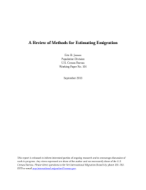
An official website of the United States government
Here’s how you know
Official websites use .gov
A .gov website belongs to an official government organization in the United States.
Secure .gov websites use HTTPS
A lock (
) or https:// means you’ve safely connected to the .gov website. Share sensitive information only on official, secure websites.
-
//
- Census.gov /
- Library /
- Census Working Papers /
- A Review of Methods for Estimating Emigration
A Review of Methods for Estimating Emigration
A Review of Methods for Estimating Emigration
Abstract
International migration statistics measure the movement of people across national borders and often comprise estimates of immigration (migration into a country) and emigration (migration out of a country). Emigration is one of the most difficult components of population change to estimate because the emigrant population is no longer resident in the country and, therefore, cannot be measured directly using censuses or surveys. Researchers and national statistical agencies have used various data, including population registers and surveys, and techniques, including residual methods, data attrition methods, indirect estimation, multiplicity sampling methods, and statistical modeling to estimate emigration. However, the literature describing how these data and techniques are used to estimate emigration is relatively sparse. In addition, foreign language translations are often unavailable, limiting the access of this information to an international audience. One of the projects of the Suitland Working Group is to bring together the published literature on estimating emigration from different languages into one resource document. In this report, we summarize the literature on the methods to estimate emigration, review the strengths and limitations of each method, and provide references for original documents in English, French, German, Italian, and Spanish.
Others in Series
Working Paper
Working Paper
Working Paper
Share
Some content on this site is available in several different electronic formats. Some of the files may require a plug-in or additional software to view.
 Yes
Yes
 No
NoComments or suggestions?


Top

